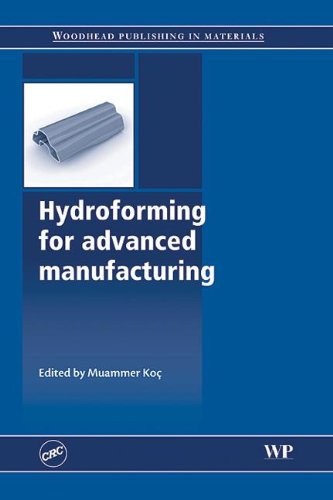Articoli correlati a Hydroforming for Advanced Manufacturing

After an introduction, the first part of the book reviews the principles of hydroforming, from equipment and materials to forming processes, design and modelling. The second part of the book reviews the range of hydroforming techniques, the shaping of particular components and the application of hydroforming in aerospace and automotive engineering.
With its distinguished editor and team of contributors, Hydroforming for advanced manufacturing will be a valuable reference for all those developing and applying this important process.
Le informazioni nella sezione "Riassunto" possono far riferimento a edizioni diverse di questo titolo.
Introduction and State-Of-The-Art Of Hydroforming
M Koç and O N Cora, Virginia Commonwealth University, USA
Introduction. Hydroforming systems, equipment, tooling and controls. Materials, formability, forming limits, advantages. Tribology in hydroforming-friction, wear, lubricants, coatings and testing methods. Computer simulations for tube hydroforming. Developments in hydroforming and concluding remarks. References.
PART 1 PRINCIPLES OF HYDROFORMING
Hydroforming Systems, Equipment, Controls and Tooling
D Gearing and D Mevissen, Interlaken Technology Corporation, USA
Introduction. Presses. Pressure intensification systems. Controls. Tooling. Future trends. Sources of further information and advice. References.
Deformation Mechanism and Fundamentals of Hydroforming
C Hartl, Cologne University of Applied Sciences, Germany
Introduction. Stress and strain relationships in tube hydroforming. Determination of forming limits. Forming loads and process control. Preceding forming operations. Tube bending. Preforming. References.
Materials and Their Characterization for Hydroforming
C Hartl, Cologne University of Applied Sciences, Germany
Introduction. Steel materials. Aluminium and magnesium alloys. Formability testing. Future trends. References.
Formability Analysis for Tubular Hydroformed Parts
D E Green, University of Windsor, Canada
Introduction. Tube formability. Measuring tube formability. Tube forming limits. Formability analysis for numerical simulations. Formability analysis in the plant. Conclusions and future trends. References.
Design and Modeling of Parts, Process and Tooling in Tube Hydroforming
M Strano, Università degli Studi di Cassino, Italy
Introduction to tube hydroforming design issues. Technological classifications of tube hydroforming processes. The hydroformability of tubular parts. Guidelines for process design. Finite element analysis (FEA) strategies for process design. Designing a new hydroforming process: a simple example. References.
Tribological Aspects in Hydroforming
G Ngaile, North Carolina State University, USA
Introduction. Parameters that influence friction, lubrication, and wear. Style. Lubrication mechanisms. Development and evaluation of hydroforming lubricants. Impact of numerical modelling in hydroforming tribology. Concluding remarks. References.
PART 2 HYDROFORMING TECHNIQUES AND THEIR APPLICATIONS
Pre-Forming: Tube Rotary Draw Bending and Pre-Flattening/Crushing in Hydroforming
G Khodayari, Vari-Form, Canada
Introduction. Concept of rotary draw bending process. Material behavior in rotary draw bending process. Pre-flattening/crushing. Part design and tube formability. Conclusion. References.
Hydroforming: Hydropiercing, End-Cutting, and Welding
L M Smith, Oakland University, USA
Introduction. Hydropiercing. End cutting. Welding. References.
Hydroforming Sheet Metal Forming Components
K Siegert and S Wagner, Universität Stuttgart, Germany
Introduction. Hydroforming processes. Dies and presses for hydromechanical deep drawing. References.
Bending and Hydroforming of Aluminum and Magnesium Alloy Tubes
A A Luo and A K Sachdev, General Motors Research & Development Center, USA
Introduction. Aluminum and magnesium alloy tubes. Aluminum tube bending and hydroforming. Magnesium tube bending. Forming at elevated temperatures. Automotive applications and future trends. Acknowledgements. References.
Low Pressure Tube Hydroforming
G Morphy, Excella Technologies Inc., Canada
Introduction. Low pressure hydroforming. Part characteristics. Cross section performing. Conclusions. References.
Comparative Analysis of Hydroforming Techniques
G Morphy, Excella Technologies Inc., Canada
Introduction. So many options; how to choose? Roll forming. Stampings and assemblies. Tube forming. Commonly held conceptions. Low pressure hydroforming. High pressure hydroforming. Other comparative process factors. Conclusions. References.
Fluid Cell Pressing in the Aerospace Industry
M Bergkvist, Avure Technologies AB, Sweden
Introduction. Evolution of the technology. How fluid cell pressing works. Recent developments. The essentials of ductile materials. Suitable part applications. Tools (form blocks). Part manufacture. Conclusion.
Hydroforming and its Role in Lightweighting Automobiles
G Morphy, Excella Technologies Inc., Canada
Introduction. What makes it so difficult to lose weight? How to reduce weight. How tube hydroforming can reduce weight. Weight loss limitations and how to address them. Conclusions. References.
Warm Hydroforming
M Koç, Virginia Commonwealth University, USA
Introduction: motivation for lightweight vehicles. Lightweight materials: advantages and manufacturing issues. Forming technologies for lightweight materials. Warm hydroforming: state-of-the-art review. Comparison of warm and cold hydroforming: a numerical study. Process design and control in warm hydroforming. Characterization of materials for warm hydroforming conditions. References.
Le informazioni nella sezione "Su questo libro" possono far riferimento a edizioni diverse di questo titolo.
Spese di spedizione:
GRATIS
In U.S.A.
I migliori risultati di ricerca su AbeBooks
Hydroforming for Advanced Manufacturing
Descrizione libro Hardcover. Condizione: Good. No Jacket. Former library book; Pages can have notes/highlighting. Spine may show signs of wear. ~ ThriftBooks: Read More, Spend Less 1.65. Codice articolo G1420077864I3N10

